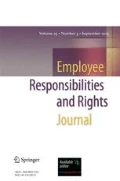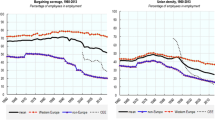Abstract
During the stagflation of the late 1970s, unions played a role in worsening inflation in some countries but not in others. This can be attributed to differences in laws governing the bargaining process. In continental Europe, each large sector of the economy is generally covered by a single collective bargaining agreement that provides for standardized wages. In the United States and the United Kingdom, there are a multitude of collective bargaining agreements. These are usually specific to a single employer, sometimes to specific worksites and even specific types of workers at that site. The result is a hodgepodge of wage rates. This fractionalized bargaining process fueled inflationary wage demands and labor strife. Among the explanations is the theory of relative deprivation that people are primed to focus on disparities.
Similar content being viewed by others
Notes
As reported to me by Joe Bader, a former colleague, and the union staff member assigned as negotiator in the situation described.
There have been periods when, at the insistence of management, unions accepted “two tier” wage systems where more recent hires got paid less for the same work as previous hires. So far as I know, unions invariably protested, though not always successfully, and in subsequent negotiations fought, often with success, to undo the two tier systems by granting newer employees higher increases.
References
Bureau of the Census. (1983). World population 1983: Recent demographic estimates for the countries and regions of the world. Washington, D.C.: Department of Commerce. https://play.google.com/books/reader?id=XA42PtWFuVAC&printsec=frontcover&source=gbs_atb_hover&pg=GBS.PR1. Accessed 29 Mar 2014.
Erickson, C., & Mitchell, D. (2007). Monopsony as a metaphor for the emerging post-union labour market. International Labour Review, 146(3–4), 163–187.
Freeman, R., & Medoff, J. (1984). What do unions do? New York: Basic Books.
Golden, M., Wallerstein, M., & Lange, P. (2008). Postwar trade-union organization and industrial relations in twelve countries. In D. Austen-Smith et al. (Eds.), Selected works of Michael Wallerstein. Cambridge: Cambridge University Press.
Hindess, B. (1982). The decline of working class politics: a reappraisal. In B. Pimlott & C. Cook (Eds.), Trade unions in British politics. Burnt Mill: Longman Group.
Inflation.EU. (2017). Available at http://www.inflation.eu. Accessed 20 Sep 2017.
International Labor Organization. (2017). Germany - http://www.ilo.org/ilostat-files/WEB_bulk_download/ref_area/DE2_A.csv.gz; Great Britain - http://www.ilo.org/ilostat-files/WEB_bulk_download/ref_area/GBR_A.csv.gz; United States - http://www.ilo.org/ilostat-files/WEB_bulk_download/ref_area/USA_A.csv.gz: . Accessed 14 Oct 2017.
Mitchell, D. (1980). Unions, wages, and inflation. Washington, D.C.: The Brookings Institution.
Moore, B., Jr. (1978). Injustice: The social bases of obedience and revolt. White Plains: M.E. Sharpe.
Runciman, W. (1966). Relative deprivation and social justice: A study in attitudes to social inequality in twentieth-century England. London: Routledge & Kegan Paul.
Sturmthal, A. (1972). Comparitive labor movements: Ideological roots and institutional development. Belmont: Wadsworth Publishing.
Taylor, R. (1982). The trade union ‘problem’ since 1960. In B. Pimlott & C. Cook (Eds.), Trade Unions in British Politics. Burnt Mill: Longman.
Wallerstein, M. (2008). Wage-setting institutions and pay inequality in advanced industrial societies. In D. Austin-Smith et al. (Eds.), Selected works of Michael Wallerstein. Cambridge: Cambridge University Press.
Author information
Authors and Affiliations
Ethics declarations
The author declares that he has no conflicts of interest. This article does not contain any studies with human participants or animals performed by the author. There were no individual participants in this study and, thus, informed consent does not apply to this study.
Additional information
Publisher’s Note
Springer Nature remains neutral with regard to jurisdictional claims in published maps and institutional affiliations.
Rights and permissions
About this article
Cite this article
Lepie, J. Bargaining Structure and Inflation. Employ Respons Rights J 31, 189–195 (2019). https://doi.org/10.1007/s10672-019-09335-w
Published:
Issue Date:
DOI: https://doi.org/10.1007/s10672-019-09335-w




